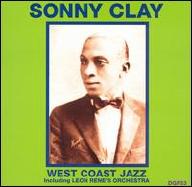There were worse problems. The boys in the band were getting lots of attention from local girls and rumors were flying about drug use. Police reports from the period indicate that Clay's bandmembers were under surveillance by an initiative of the Commonwealth Investigation Branch. Cops were busy checking out the nighttime scene at the musicians' Sydney flats in Darlinghurst, where the jazzmen were engaging in the shocking activity of entertaining white girls. Reporters would join the cops in the googling until a raid was finally conducted of two apartments occupied by six of Clay's sidemen. In the ensuing fracas, several nearly naked girls were run out of the apartment, one of them leaping from a window. Other visitors and musicians ignored the police, continuing to indulge in the sleazy pastimes of necking, drinking, and smoking. No drugs were ever found on the premises and an ensuing charge that there were was never proven. The musicians are said to have pleaded with police and reporters to keep the goings-on hushed, especially the ones wearing wedding rings. Attempts were made to bribe reporters. Clay was not there and was not involved in any of the behavior that former Australian Prime Minister Billy Hughes said would have gotten the band a lynching in the Southern states of their home country. When he called the band "the scum of America," it was decades too early to be useful in a punk publicity campaign and definitely balanced out some of the rave reviews in the band's Australian press kit. Cabinet voted to deport the men and Saturday papers brandished the headline "Federal cabinet to bar entry of all colored artists." The resulting roadblock was run by only a handful of black performers and it was not until 1954, some 26 years later, that Louis Armstrong His All-Stars toured Australia. The effect on the Australian jazz scene was truly mind boggling, with any and all stylistic innovations during this period handed down to public scrutiny only after being mangled by white Australian jazz bands. Clay broke up his band in the early '30s and mainly played solo piano in Los Angeles night clubs until his World War II Army induction. In uniform, his music-making continued, as he was set up as a bandleader in the Special Services Division. After the war, he returned to solo club gigs until declining health led him to go to work for the post office with some piano tuning work on the side. In the late '50s, interest in his work forced him out of retirement and was he back as a club pianist. In 1960, he recorded a session for producer John Bentley that was finally released 25 years later on the Harlequin label. ~ Eugene Chadbourne, Rovi
Sonny Clay
Biography
Is Clay of vital importance of to the development of jazz in Australia? What sounds like a surrealist trivia question makes sense only when it is revealed that the Clay in question is pianist Sonny Clay, a bandleader of some reknown who can righteously claim to have had Ivie Anderson vocalizing in front of his big band years before the great Duke Ellington discovered her. Clay led a batch of different bands in the '20s, including the California Poppies, the Stomping Six, Sonny Clay's Plantation Orchestra, Sonny Clay His Orchestra, and Sonny Clay's Hartford Ballroom Orchestra. All well in good, but what does it have to do with the land down under where the kangaroos hop? This will be revealed following a bit more of the sometimes longwinded background of the man named William Rogers Campbell Sonny Clay. He was born near the close of the 19th century and by 1908 had relocated to Phoenix, AZ, where he began his study of music on the piano, drums, xylophone, and C-melody saxophone. He began playing professionally in bands around the Phoenix area after leaving school, including a position with a small group that played for students at an Arthur Murray dance studio. He was the classic wandering minstrel by 1918, working in one small instrumental group after another on whichever instrument was most needed, drums or piano. He played up and down the West Coast, even hitting Tijuana, Mexico, where legend is he jammed with Jelly Roll Morton. In the early '20s, Clay was based in Los Angeles, gigging with groups such as Reb Spikes' Famous Syncopated Orchestra and on drums with the celebrated Kid Ory's Sunshine Orchestra. Clay began recording shortly thereafter, beginning with some work as a piano accompanist to the young blues singer Camille Allen and continuing with two sides of his own on the Sunset label. He continued recording for Sunset, including piano solos, as well as new group projects, and then began cutting sides for Vocalion from 1925 onwards. His group had a regular stint at the Los Angeles Plantation Club, getting a chance to polish many of Clay's own compositions and refine the personnel until he arrived at the group that he brought to Australia on tour at the outset of 1928. Jazz audiences down under were literally reeling from these shows, as nothing remotely resembling the band had ever been heard live there before. The white Australian jazz bands of the period couldn't even come close to creating such an atmosphere of New Orleans jazz. The Australian tour was a package event that also included gospel groups, as well as the then 23-year old singer Anderson, but it was Clay's band that seemed to be getting the most attention, not all of it welcome. A shift in bookings from vaudeville stages to dance band halls turned out to be entrapment, pushing the band into violating union regulations for their work permits as well as boundaries on venues that could be entered by so called "coloured races" -spelling, and concept, courtesy of the British Commonwealth.
Top Tracks
Albums
Videos
Close












